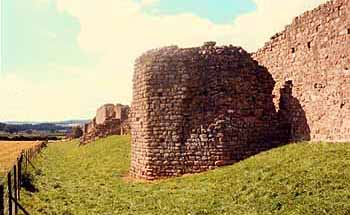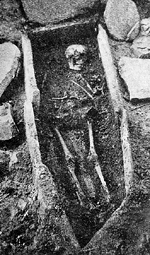
EBK Home
Kingdoms
Royalty
Saints
Pedigrees
Archaeology
King Arthur
Mail David
CAERWENT
The Welsh Winchester
 Caerwent,
the eponymous town of Gwent, is rarely associated with King
Arthur. However, modern theories suggest a major connection.
Caerwent,
the eponymous town of Gwent, is rarely associated with King
Arthur. However, modern theories suggest a major connection.
The Tradition: King Caradog Freichfras (Strong-Arm) of Gwent's main court was originally at Caer-Guent (Caerwent), but he gave the city to St. Tathyw, while the King let his horse lead him to a new home at Portskewett. Tathyw founded a monastery to the Holy Trinity at Caer-Guent. He lived there many years with his followers and when he died he was buried under the floor of his Abbey Church.
At the same time, Sir Thomas Malory tells us in his "Le Morte D'Arthur" that Camelot was "called in English, Winchester". He reports of the main church there that twelve of Arthur's defeated enemies "were buried in the Church of St. Stephen's in Camelot" and that Arthur "the King was wedded at Camelot unto Dame Guenever in the Church of St. Stephen's, with great solemnity." Caxton, Malory's publisher, however, clearly states in the book's introduction that Camelot was in Wales. Chrétien De Troyes, the man to first coin the phrase Camelot, relates, in his tale of Lancelot, how Arthur held court there having recently moved on from Caerleon, thus implying the proximity of the two.
The Theory: A hypothesis, particularly stressed by Barber and Pykitt, suggests that Malory knew well the identification of the Arthurian Camelot with the Roman town of Venta. However, possibly influenced by existing Medieval tradition, he misinterpreted this as the town of Venta Belgarum (Winchester) rather than Venta Silurum (Caerwent). Or maybe readers have simply misunderstood Malory's writings. He writes "Camelot that is (called) in English, Winchester". Caerwent (alias Camelot) would indeed be called Winchester if translated from Welsh into English.
 Modern
Archaeology: Major
excavations throughout Caerwent have revealed many of the impressive
buildings and everyday objects from the Roman Venta Silurum. Some finds
such as Theodosian coin hoards may have been deposited in the ground as
late as 425. Metalwork, including elaborate penannular brooches and
fastening pins, have been dated to the 5th/6th and 7th centuries.
Modern
Archaeology: Major
excavations throughout Caerwent have revealed many of the impressive
buildings and everyday objects from the Roman Venta Silurum. Some finds
such as Theodosian coin hoards may have been deposited in the ground as
late as 425. Metalwork, including elaborate penannular brooches and
fastening pins, have been dated to the 5th/6th and 7th centuries.
The main Dark Age finds, however, were a large number of burials discovered in two cemeteries. 148 east-west orientated Christian graves, dating from between the 4th and 9th centuries, were discovered around the town's East Gate in 1910 and 1973. The area was a sophisticated burial ground with sections for both adults and the young, and some graves were stone-lined. The second cemetery was around the present Parish Church of St. Stephen (originally St. Tathyw confused with St. Tathan and then St. Stephen - both shared the same feast day). This consisted of 150 graves, some early enough to respect the old Roman street-plan.
Possible Conclusions: The only stone-lined burial discovered at the East-Gate in 1910, was immediately proclaimed to be St. Tathyw and reburied in the Parish Church under an elaborate Latin-inscribed memorial slab. However, later investigation revealed this grave not to be unique and its siting contradicts the traditional location in the floor of the church. Indeed, records of St. Tathyw's relics at Tewkesbury indicate that he was reinterred in a reverential shrine some time prior to 1235. His monastery may actually have been at Christchurch, eight miles east of Caerwent.
A residence for King Caradog at Caerwent would seem quite natural but, in light of Barber & Pykitt's theory, it seems probable that he inherited the town on the death of his High-King, Arthur, at the Battle of Camlann. Caerwent was Camelot with its Church of St. Stephen. The 6th century burials surrounding it probably included Malory's twelve rebellious Kings.
